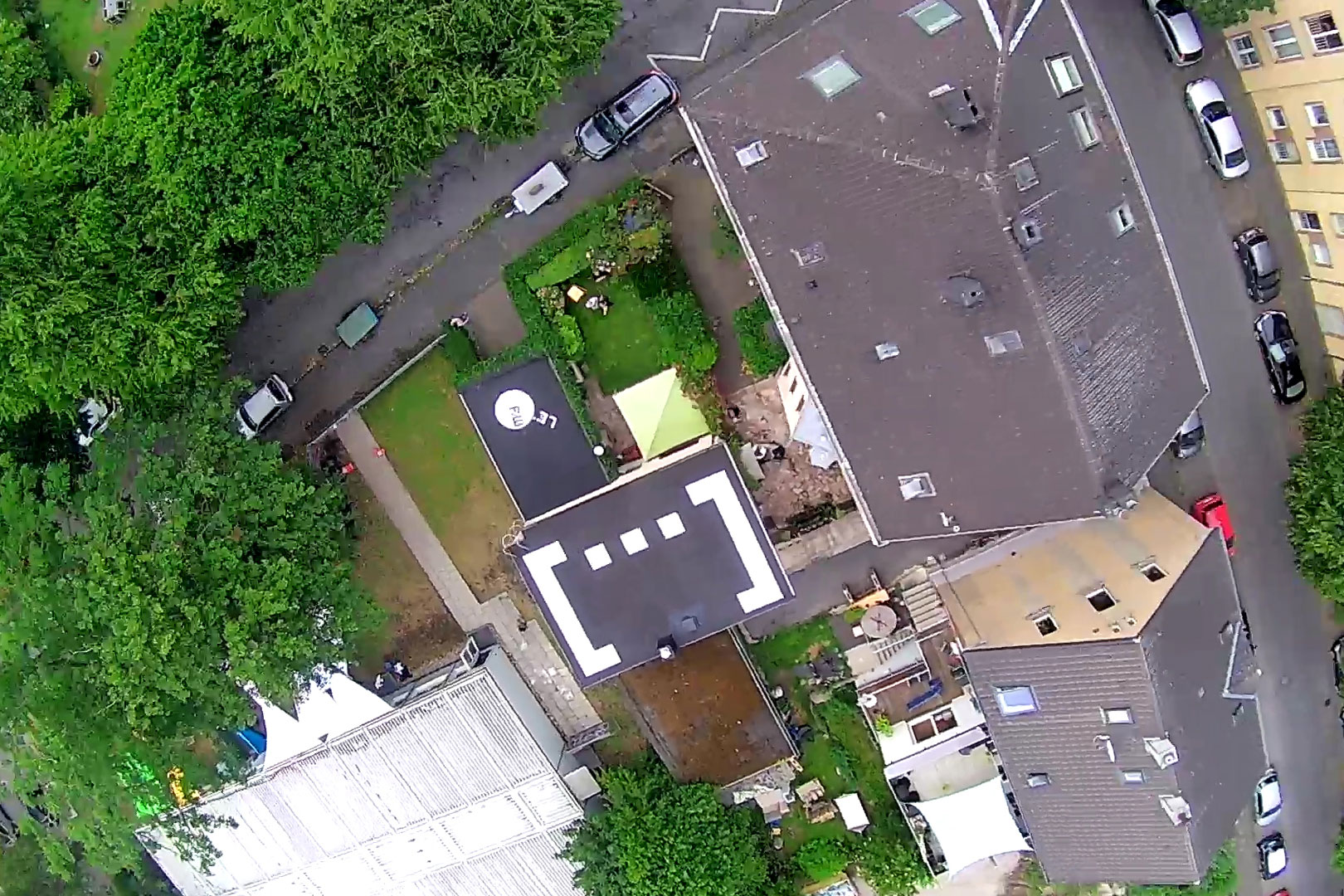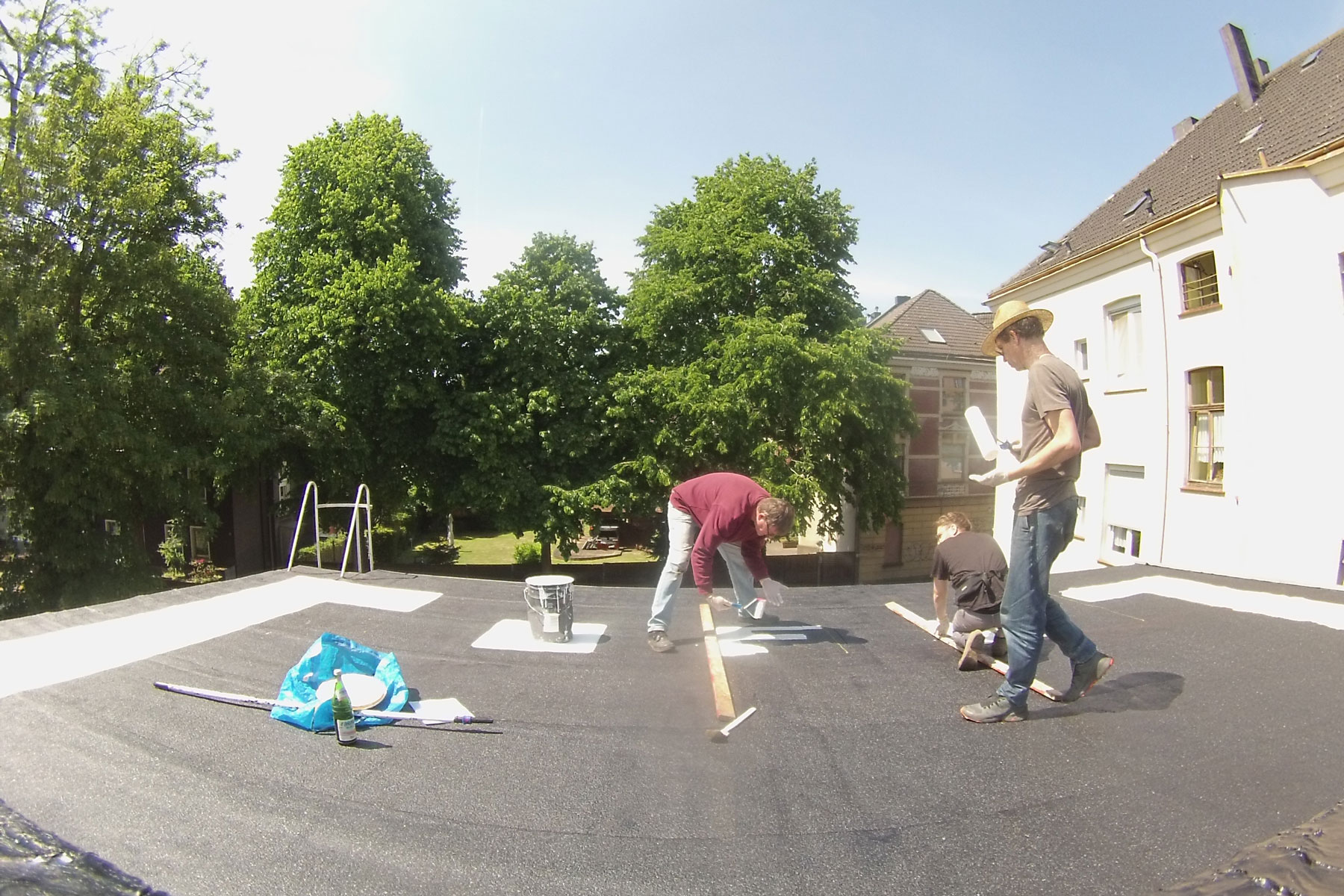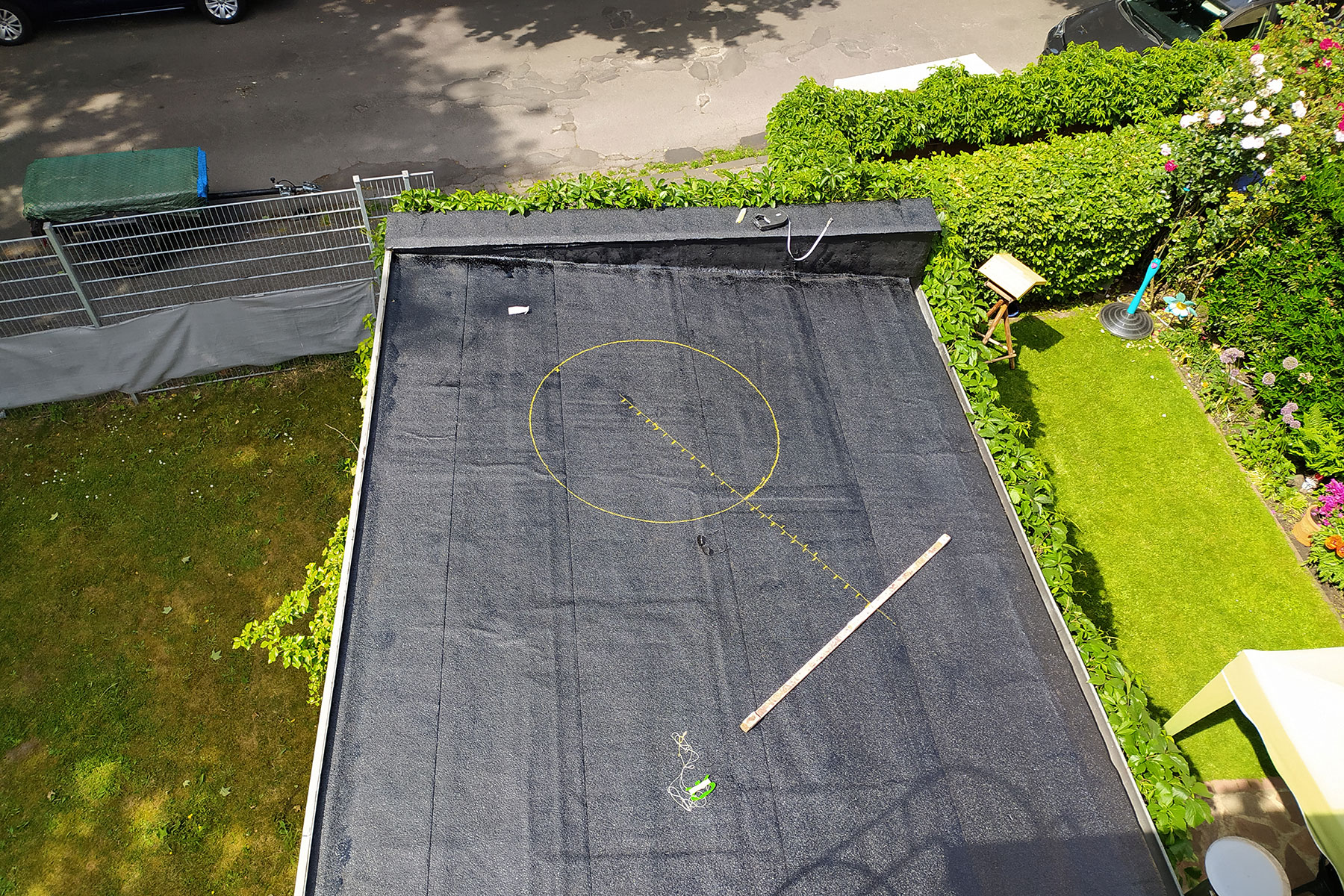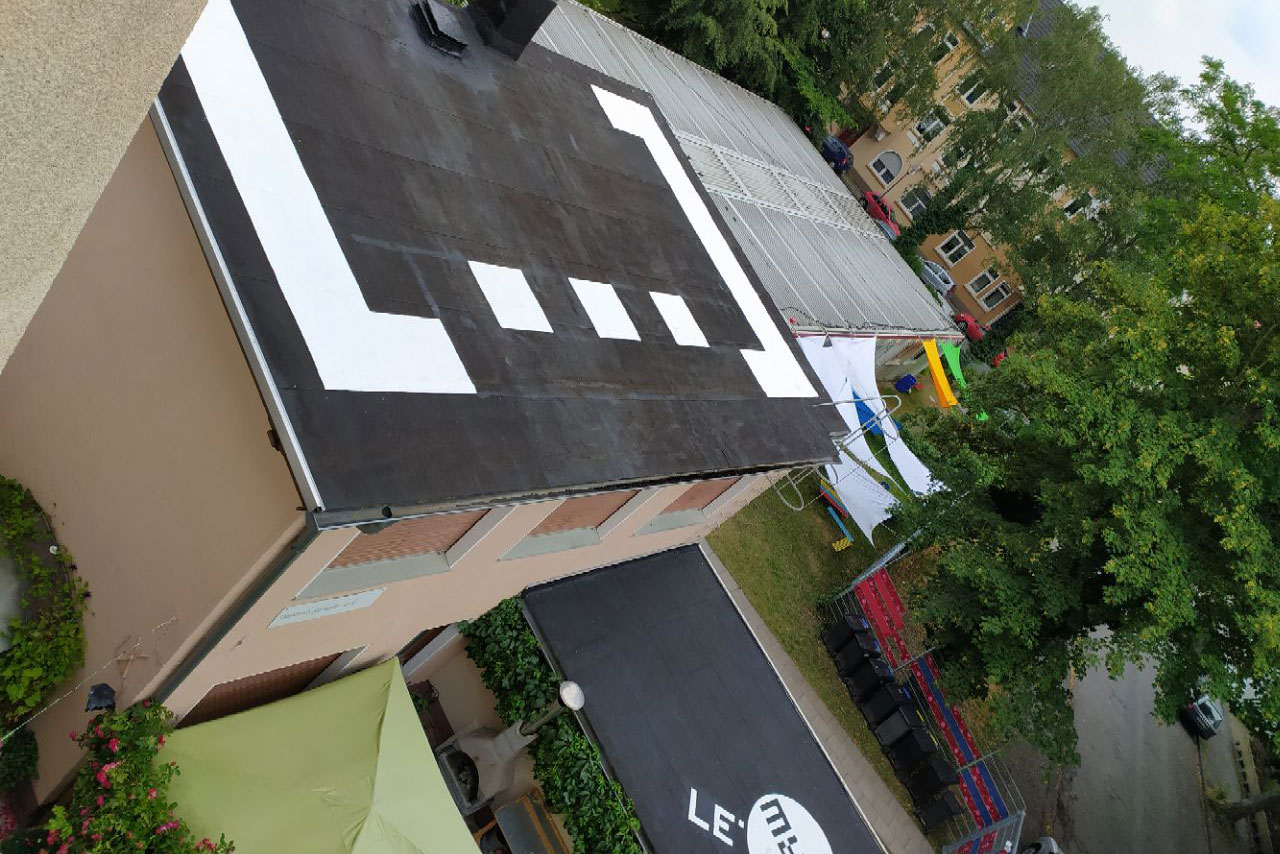REMOTEWORDS writes, delayed due to the pandemic, […], (a square bracket with three dots) on the roof of the galerie januar. It is a text without words, consisting of a sequence of punctuation, in the form of an indexical reference, semantically only accessible in context.
A sign of punctuation is used in literature, scientific texts and essays when the continuation of a sentence or a text is symbolized, but if there is not enough space for the text to be transferred. This corresponds to the architectural conditions of the Bochumer Kunstverein, whose roof only covers 54 square metres. Symbolically, the bracket fits the roof perfectly in the aspect ratio; it symbolizes (art) space, a space for one’s own free thoughts, without limits, without a point at the end of a sentence. The parenthesis thus stands for a (text) blank space that the Google Earth user as well as the visitor of the Kunstverein will fill himself. This is symbolic of the galerie januar’s self-image, which occupies and offers this very free space within social structures, a free space that goes beyond the boundaries of a roof. REMOTEWORDS‘ method of conveying a message in a few words in a short and concise way is realized in this project in the most concentrated form possible, without any communication deficit.
RW.37 takes place on the occasion of the 40th anniversary of the galerie januar 25.07 – 30.08.2020.
Installed | Location | GPS: 26-05-2018 | Galerie Januar, Bochum, Germany | 51.475214,7.3018864
Author | Words | Curator: REMOTEWORDS | […] | Ulrich Fernkorn
Roof Size | Font Size: 54 qm | 8,20 m x 5,20 m
On Air: –
INTERVIEW
„Blick zurück nach vorne“
REMOTEWORDS Auch dieses Projekt ist vom alles beherrschenden Thema der Pandemie beeinflusst, denn wir installieren verspätet, was die Google Earth Update-Wahrscheinlichkeit für das Jubiläumsjahr der galerie januar nicht gerade erhöht. Weiterhin erfährt die Nachricht eine andere Bedeutung in „Post-Corona-Zeiten“. Wir haben uns aber bereits im Januar über den „Inhalt“ dieser Zusammenarbeit verständigt, also zunächst einmal eine Frage die Prä-Corona zu beantworten ist: Was hat Ihnen an unserem Vorschlag gefallen? Inwiefern identifiziert sich der Kunstverein mit einem Verweis auf einen Text ohne Worte, eine Leerstelle, die zu füllen ist?
galerie januar […] Prima vista gefallen hat uns die Prägnanz des Visuellen, die Stimmigkeit der Größenverhältnisse auf unserer vergleichsweise kleinen Dachfläche, ebenso das Minimalistische, das bestens zu unserem Ausstellungsprogramm passt, weil dieses zwar nicht ausschließlich, aber über Jahrzehnte doch stark von ungegenständlichen, konkreten Positionen bestimmt war. In den drei übereinander liegenden Räumen des Hinterhauses haben wir von Beginn an meist einem „weniger ist mehr“ den Vorzug gegeben vor überinszenierten oder übervollen Ausstellungen: je weniger man zeigt, desto genauer wird der Blick auf die räumliche Anordnung der Werke und deren Abstände zueinander, ja mitunter wird der Leerraum zwischen den Elementen eines Werkes – in einer Installation beispielsweise – genauso wichtig wie die Elemente selbst. Eben eine solche Genauigkeit für die räumliche Disposition und die Wichtigkeit des Leerraums in der vorgeschlagenen REMOTEWORDS „Zeichnung“ war für uns sofort schlagend.
REMOTEWORDS Es handelt sich um einen Text ohne Buchstaben, ein symbolisch geladenes Bild, bestehend aus Interpunktionen, ein Zeichen, das in einem kulturellen Code eingebettet auf etwas verweist. Dieses Zeichen ist aber nicht unbedingt jedem, der des Lesens mächtig ist, vertraut, sondern eher denjenigen, die sich mit Texten, mit Sprache beschäftigen. REMOTEWORDS definiert sich als Verbreiter von Texten durch (Luft)Bilder, (Satelliten)Fotografie. Vielleicht kann man bildlich gesehen bei (…) sogar von einem indexikalischen Zeichen im doppelten Sinne sprechen, einmal als Code und auf der Metaebene, als der Verbreitung von Texten durch Fotografie. Sehen Sie hier auch einen Zusammenhang und ist er auf das Programm des KV ausweitbar?
galerie januar Die Offenheit des Auslassungszeichens empfinden wir als besonders passend für unsere Tätigkeit. Denn über alle visuelle Stimmigkeit hinaus sollte ja auch die inhaltliche Bedeutung des Zeichens der programmatischen Ausrichtung unseres Kunstvereins entsprechen: In der Geometrie der flankierenden eckigen Klammern, die gleichsam die Rechtwinkligkeit der darunter liegenden Ausstellungsräume aufnimmt, ist mit dem buchstabenlosen Dreipunkt auf eben jene Offenheit verwiesen, welche die galerie januar als experimentelle Plattform für die junge, oft noch weitgehend unabgesicherte Gegenwartskunst immer wieder neu herausfordert. Da gerade die jüngsten Erscheinungsformen der Gegenwartskunst in ihrer ganzen Vielfalt stets anders sind als unsere mitgebrachten Erwartungen an sie, geht die Ausstellungs- und Vermittlungstätigkeit der galerie januar nicht so sehr von vorgefassten, theoretisch vorformulierten und etablierten Kunstbegriffen aus. Sie gestaltet sich demgemäß offen und flexibel, wenn auch nicht beliebig. Dafür ist nicht zuletzt das Wissen um die lange Geschichte der Kunst von grundlegender Bedeutung und mit der 40jährigen Geschichte dieser Institution verbunden: Denn so wie sie 1980 als studentische Initiative im Umkreis des kunsthistorischen Instituts der Ruhr-Universität Bochum gegründet worden ist und sich im Lauf der Zeit auch mit jungen Kunsthistoriker innen immer wieder verjüngt hat bleibt es das Ziel, die erlernte Theorie an der jeweils aktuellen Praxis der Kunst zu überprüfen. Die galerie januar richtet ihren Blick bis heute – janusköpfig – aus der Kunstgeschichte zurück nach vorn und versucht, aus deren Kenntnis über zukunftsträchtige Entwicklungen der Gegenwartskunst auf dem Laufenden zu halten. Auch diese doppelte Bewegung zwischen Vergangenheit und Zukunft der Kunst kann man wohl mit Recht in dem Auslassungszeichen repräsentiert sehen, weil dieses bekanntlich gekennzeichnet ist dadurch, dass ihm in der Vorstellung sowohl ein Text vorangeht wie auch nachfolgt. Wahrscheinlich spielt es für die Überzeugungskraft des Auslassungszeichens sogar eine Rolle, dass es uns aus dem akademischen Alltag wissenschaftlicher Texte von vornherein vertraut ist: Denn ähnlich wie die Künstler ihr Werk ja stets im Rückblick auf die bereits vorhandene Kunst schaffen (müssen), haben es ja auch Kunsthistoriker in ihrer Forschungsaufgabe ebenso mit geschaffenen Werken wie zugleich mit Texten zu tun, welche diese begleiten und auf die sie sich zitierend beziehen müssen. Auch REMOTEWORDS steht ja „auf den Schultern von Riesen“, insoweit sich die Projekte zurückbeziehen lassen auf bestimmte Formen der Kunst mit Sprache und die Landart, die sie aber unter den fortgeschrittenen Bedingungen der digitalen Technik zeitgenössisch interpretieren. Auch das trägt zweifellos zur Attraktivität und „Anschlussfähigkeit“ des Projekts für die galerie januar bei, dass sie mit RW.37 im Sinne der Verbreitung des Auslassungszeichen durch Fotografie und Internet den Bereich der Neuen Medien gegenüber den traditionellen Ausdrucksformen wie Malerei und Skulptur in ihrem Ausstellungsprogramm gewissermaßen mit einem Ausrufezeichen für ihre Zukunft versehen kann.
REMOTEWORDS Was wären die Worte, die Sie bzw. der Verein innerhalb der Klammer sehen würden?
galerie januar Das wäre die, für unsere Vereinstätigkeit seit langem geltende Sentenz, „Blick zurück nach vorne“.
REMOTEWORDS This project is also influenced by the all-dominant topic of the pandemic, because we are installing delayed, which does not really increase the Google Earth update probability for this year’s jubilee of the galerie januar. Furthermore, the message takes on a different meaning in „post-corona times“. However, we already agreed on the „content“ of this cooperation in January, so first of all a question that needs to be answered pre-corona: What did you like about our proposal? To what extent does the Kunstverein identify itself with a reference to a text without words, a blank space to be filled?
galerie januar […] – Prima vista we liked the conciseness of the visual, the coherence of the proportions on our comparatively small roof area, as well as the minimalism, which fits in perfectly with our exhibition program, because it was not exclusively, but for decades strongly determined by non-figurative, concrete positions. In the three rooms of the back building, which are located one above the other, we have usually preferred „less is more“ to over-staged or overfilled exhibitions from the very beginning: the less you show, the more precise the view at the spatial arrangement of the artworks and their distances to each other becomes, and even the empty space between the elements of a work – as in an installation, for example – becomes just as important as the elements themselves. It was precisely this kind of precision for the spatial disposition and the importance of the empty space in the proposed “drawing” by REMOTEWORDS that immediately struck us.
REMOTEWORDS It is a text without letters, a symbolically loaded image consisting of punctuations, a sign embedded in a cultural code that refers to something. This sign is not necessarily familiar to everyone who can read, but rather to those who deal with texts, with language. REMOTEWORDS defines itself as a distributor of texts through (aerial) images, (satellite) photography. Perhaps one can even speak figuratively of […] as an indexical sign in a double sense, on the one hand as a code, and on the meta-level as the spreading of texts through photography. Do you also see a connection here and can it be extended to the program of the Kunstverein?
galerie januar We find the openness of the ellipsis particularly appropriate for our activity. Beyond all visual coherence, the content-related meaning of the sign should also correspond to the programmatic focus of our Kunstverein: In the geometry of the flanking square brackets, which also takes up takes up the rectangularity of the exhibition spaces situated underneath, the letterless three-point sign refers to the very openness that constantly challenges the galerie januar as an experimental platform for young, often still largely unsecured contemporary art. Since it is precisely the most recent manifestations of contemporary art in all their diversity that are always different from the expectations we have of them, the exhibition and mediation activities of galerie januar are not so much based on preconceived, theoretically pre-formulated and established art concepts.
REMOTEWORDS What would be the words you or the Kunstverein see within the parentheses?
galerie januar That would be the longstanding aphorism for our association’s activities, „Look back to the future“.














